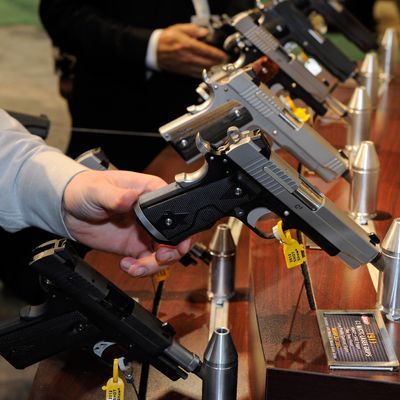
If you follow the money, it appears that some of the people whose money was used to build the company that manufactured the gun that Adam Lanza used to kill students and teachers in Newtown last week were, tragically, teachers themselves.
Dan Primack reports that the California State Teachers’ Retirement System (CalSTRS) “effectively owns a 6.67% stake” in Bushmaster — the company whose semiautomatic .223 rifle was used in the deadly Sandy Hook rampage — by virtue of its investment in Cerberus Capital Management, the private-equity firm that owns the Freedom Group, Bushmaster’s parent company.
A list of Cerberus’s investors isn’t publicly available, but it appears that at least two additional teachers’ pension funds (and probably more) have money invested in the firm: the Teacher Retirement System of Texas, which listed Cerberus among a group of investors to which it had paid fees in its most recent annual report [PDF], and the Pennsylvania Public School Employees’ Retirement System, which reportedly allocated $400 million to the Cerberus fund that was used to bankroll the Freedom Group.
As politicians sort through the legislative ramifications of Friday’s shooting, indirect investors in the Freedom Group and other gun manufacturers may start asking tough questions about where their money is going.
It’s easy to measure the impact that the Newtown shooting has had on publicly traded gun makers. Bloomberg reports that Smith & Wesson, the firearms maker, has seen its stock price slide 8.2 percent in the period since the Newtown shooting, while Sturm, Ruger & Company — whose Ruger Mark .177 Break-Barrel Pistol is available for $64.97 at Wal-Mart — is down 5.5 percent.
But Bushmaster, as a private company within a private-equity firm, is more shielded from the effects of a disaster involving its products.
That is, unless investors in the pension funds who bankroll the company start agitating. Eliot Spitzer writes in Slate that “it is time to determine pension fund by pension fund who has invested in Cerberus and bring pressure on those investors either to get out of Cerberus or have Cerberus change the way it runs the gun industry.” And Primack got a spokesman for the California State Teachers’ Retirement System on the phone who told him that the pension fund’s indirect investment in Bushmaster, via Cerberus, was “something that we will be discussing going forward.”
Spokespeople for the Texas and Pennsylvania funds did not immediately return my e-mails.
Private-equity firms don’t generally care what the general public thinks of their investments. But the opinions of major pension funds and endowments who provide firms with capital do matter. If investors like CalSTRS and Texas Teachers were to pull their money from Cerberus funds, citing pressure from members or a violation of their social responsibility codes, it could send a strong message to the fund. And if enough investors pull their money, it’s conceivable that Cerberus could be pressured into changing the way it manufactures and sells firearms.
Primack makes a good case for why public pension funds and endowments should at least consider divesting themselves from Cerberus and other owners of gun manufacturers:
Profit should be the primary goal of their investment offices, but not at the expense of their broader purposes. If a schoolteachers union or university endowment or nonprofit foundation truly cares about stopping the next mass killing, then they should not provide capital that produces the instruments of such destruction.
Even before the Newtown shooting, Freedom Group and Cerberus knew about the danger new anti-gun legislation could pose to its sales. In its most recent annual report [PDF], the company listed new regulations as a risk factor for investors, writing, “The regulation of firearms and ammunition may become more restrictive in the future and any such development might have a material adverse effect on our business.”
But despite the fact that the company itself knew of the risks associated with gun manufacturing, it’s likely that some of Cerberus’s investors hadn’t paid attention to how their money was being used. In a profile of the Freedom Group last year, the New York Times wrote about how the little-known company had managed to keep a low profile despite its enormous size:
Even within gun circles, the Freedom Group is something of an enigma. Its rise has been so swift that it has become the subject of wild speculation and grassy-knoll conspiracy theories. In the realm of consumer rifles and shotguns — long guns, in the trade — it is unrivaled in its size and reach. By its own count, the Freedom Group sold 1.2 million long guns and 2.6 billion rounds of ammunition in the 12 months ended March 2010, the most recent year for which figures are publicly available.
No major gun manufacturers have released statements in the wake of the Newtown shooting, and Cerberus itself wouldn’t return Primack’s calls. But it’s safe to say that as legislators mull the proper response to the tragedy, there are some serious and somber meetings going on at the investment offices of major pension firms as well.





























